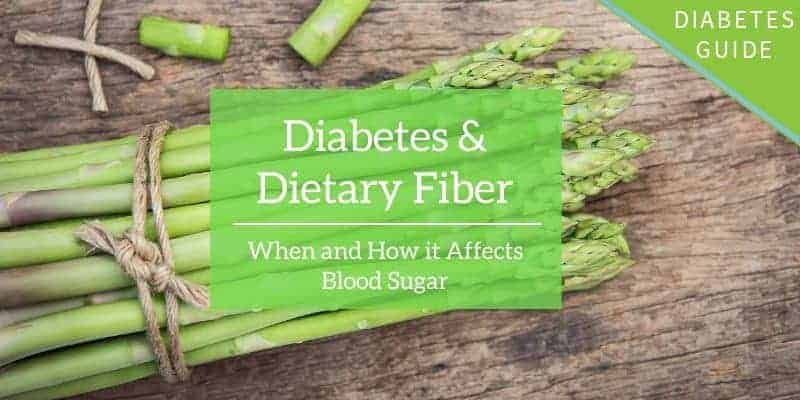Fiber is an important part of any healthy diet but can be especially important for people with diabetes who count carbohydrates to determine their insulin doses.
In this article, we’ll look at where fiber comes from, why it’s an important part of carb-counting, and why some fiber raises your blood sugar when other fiber doesn’t.

What is dietary fiber?
Often referred to as “roughage,” dietary fiber is part of the total carbohydrate amount in most plant-based foods.
“It is a type of carbohydrate found in plant foods and is made up of many sugar molecules linked together,” explains the Food & Drug Administration. “But unlike other carbohydrates (such as starch), dietary fiber is bound together in such a way that it cannot be readily digested in the small intestine.”
In layman’s terms: most forms of carbohydrates are easily broken down into glucose and absorbed through the lining of your stomach, but the majority of dietary fiber you eat is not. Which also means it doesn’t generally raise your blood sugar.
The benefits of dietary fiber
Dietary fiber can help your body in many ways:
- It slows down the rate of digestion which can help you better extract nutrients from the food you eat
- It can lessen the spike in your blood sugar after eating (because it slows down digestion)
- It helps move food through your entire digestive system more efficiently
- It helps you feel full sooner when eating
- It helps lower cholesterol levels
- And of course: it helps prevent constipation!
The most obvious symptom you’ll experience if you aren’t getting enough fiber is constipation.
How much fiber do you need?
In a 2,000-calorie diet for the average, active adult, the FDA recommends getting at least 28 grams of dietary fiber per day.
The Academy of Nutrition and Dietetics recommends the following
- Women under 50 – 25 grams of fiber/day
- Women over 50 – 21 grams of fiber/day
- Men under 50 – 38 grams of fiber/day
- Men over 50 – 30 grams of fiber/day
What foods contain fiber?
Soluble fiber: This type of fiber dissolves in water to form a “thick gel-like substance in the stomach,” explains the FDA. “It is broken down by bacteria in the large intestine and provides some calories.”
Sources of soluble fibers include:
Insoluble fiber: This type of fiber does not dissolve in water. Instead, it passes through your digestive system and isn’t broken down, which means it doesn’t supply your body with additional calories.
Sources of insoluble fibers include:
- Fruits
- Nuts and seeds
- Vegetables (such as cauliflower and green beans)
- Wheat bran
- Whole-grain foods (such as brown rice and whole-grain bread, cereals, and pasta)
There are no “good” or “bad” fibers. Both types of fiber are beneficial to your health and you should aim to eat a variety of high-fiber food.
Dietary fiber & your blood sugar
For people with diabetes who count carbohydrates — especially for those trying to determine their insulin dose for a meal — it’s important to be aware of the dietary fiber content in any food, snack, or meal.
Since dietary fiber doesn’t generally raise your blood sugar, this means you can subtract the total number of “dietary fiber” grams from the “total carbohydrate” grams listed on the nutrition panel for any food or meal.
This will give you the “net carb” content to use when determining your insulin dose with an insulin-to-carbohydrate ratio, or when simply tallying your total “net” carbohydrate consumption for the day.
For example, a medium banana contains approximately:
- 27 grams of total carbohydrate
- 3 grams of dietary fiber
- = 24 “net” carbohydrates
While that 3-gram count of fiber isn’t going to make a big difference in your insulin dose, it’s still important to note, especially if you’re eating other foods at the same time that also contain fiber.
The benefits & problems with added fiber
Nowadays, you’ll also find dietary fiber in two not-so-natural sources:
- Fiber supplements: in capsules or powder form added to water
- Diet food products: protein bars, “healthy” cookies, low-carb bread alternatives, etc.
Fiber supplements (capsules or powder)
These products can be a healthy addition to your diet to ensure easier bowel movements.
Psyllium husk capsules or powder, for example, contain pure corn husk fiber. They can be taken in capsule form every night before bed to produce a healthy bowel movement by morning. You can also buy psyllium husk in powder or “flour” form to add to baked goods or smoothies.
Other products, like Metamucil, can be mixed into water or yogurt. One thing to note on the difference between Metamucil vs. psyllium husk is that Metamucil will come with other ingredients whereas the psyllium husk is 100 percent pure corn husk.
If you struggle with healthy bowel movements, talk to your healthcare team about a fiber supplement to improve your digestive system!
The fiber in diet food products
There is an overwhelming number of highly processed “health food” products containing added fiber these days.
You might notice, for example, that your favorite protein bar has 12 grams of dietary fiber in the total carbohydrate count, which allows the manufacturer to market the bar as “low-carb” because the fiber grams can technically be subtracted from the total carbohydrate grams.
However, those 12 grams of added fiber are not the same as the natural fiber in whole food items. This means that some or even all of those fiber grams could impact your blood sugar depending on the source and whether or not it’s absorbed through the lining of your stomach during digestion.
Chicory root fiber, for example, is often added to low-carb food products to make the “dietary fiber” content appear high which makes the “net carbohydrate” content appear low.
When you dose your insulin based on those “net carbohydrates,” however, you may find your blood sugar spikes as if the carbohydrate content was higher, because some of that dietary fiber did, in fact, impact your blood sugar.
When eating these high-fiber products, take careful note of how they impact your blood sugar and how you accounted for the fiber content.
It’s also important to note that many of those high-fiber products also contain sugar alcohols which are marketed as having no impact on your blood sugar, but many do still actually convert into glucose.
Can you eat too much fiber?
Yes, it is quite possible to eat too much fiber, which can cause bloating, gas, and constipation.
How much is “too much” varies from person to person, but a good guideline is that the uncomfortable side effects of excessive fiber can occur when someone eats more than 70 grams of fiber a day. People with very sensitive digestive systems can experience side effects much sooner than that, after eating as little as 30-40 grams of fiber in a day.
For most people, eating too much fiber is not a concern as only an estimated 5 percent of Americans even meet their daily recommended fiber intake.
However, eating 70 grams of fiber in a day is really not difficult and will often happen for people who eat many high-fiber nutrition bars or follow a vegan diet so it’s worth keeping an eye on your fiber intake if you experience frequent bloating or constipation.




TX Hospitals
Understanding the impact of dietary fiber on blood sugar levels is crucial for managing diabetes effectively. This article sheds light on an important aspect of diabetic care, providing valuable insights into how fiber can influence glucose levels. It’s essential information for anyone looking to make informed dietary choices to support their health
PA Doff
“Psyllium husk capsules or powder, for example, contain pure corn husk fiber.”
Not true.
Psyllium is a form of fiber made from the husks of the Plantago ovata plant’s seeds. It sometimes goes by the name ispaghula.
Phillip Schmuck
This is very helpful information. On Saturday I had a Diabetic seizure and had to go to the emergency room; this was my own fault as I did not eat right that day. I MUST get my
blood sugar under control.
Christel Oerum
That sounds scary, I’m glad you’re ok